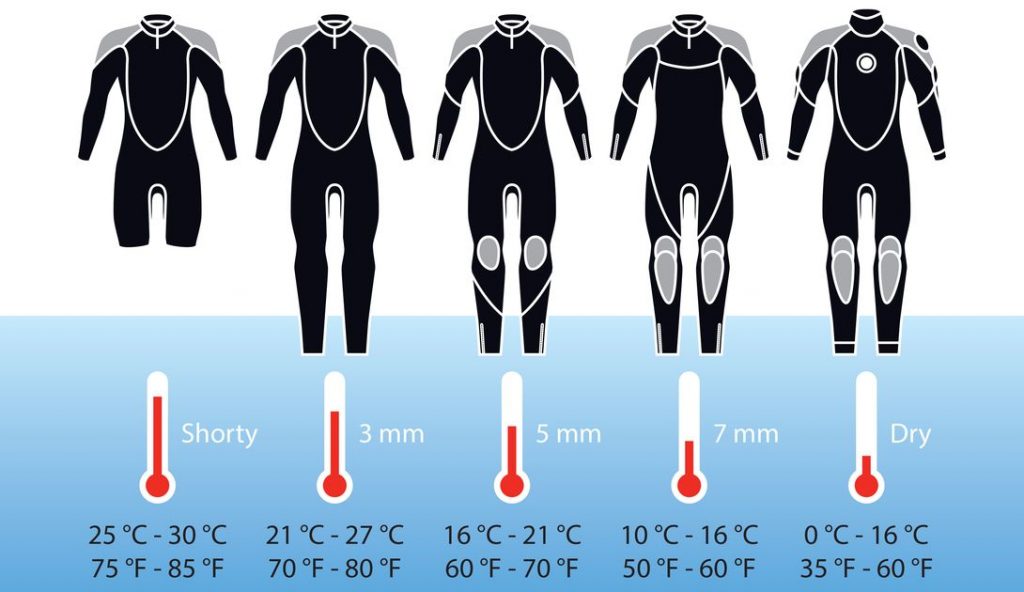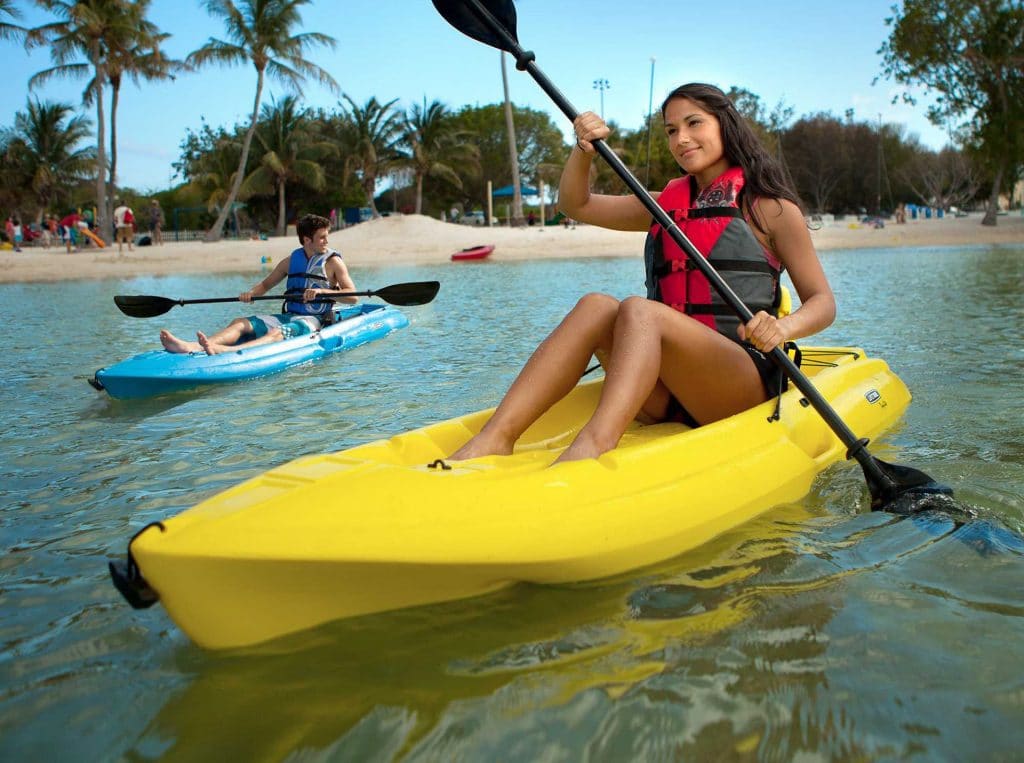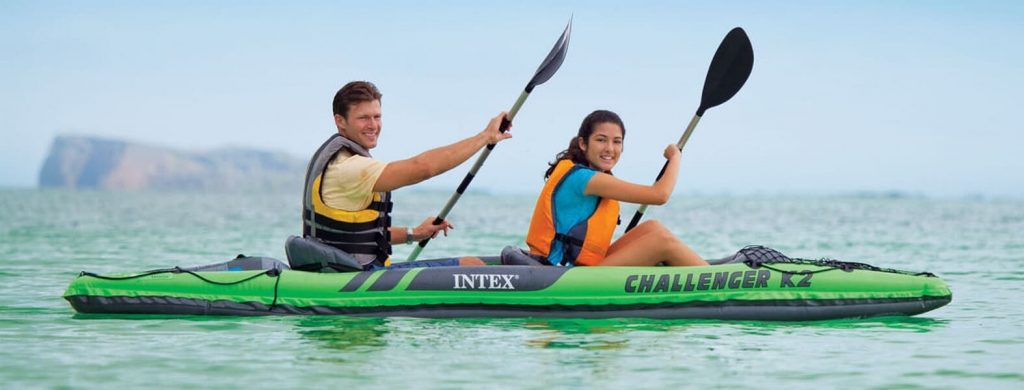

Oftentimes, the best paddling is in cold water. For whitewater kayakers, the pursuit of paddling means heading into frigid rivers when the snow is melting, or cold rain is falling. When heading into the ocean, waves and wind blowing off the surf can be surprisingly cold even when the thermometer is rising back on land. As a result, a wetsuit should be a part of every paddler’s gear. The best wetsuits for kayaking provide freedom of movement for your torso and shoulders while keeping you warm even when wet.
In order to help you find the perfect wetsuit for your adventures on the water, we considered a number of features. First, we looked at what materials different wetsuits are made from – while neoprene is the standard for wetsuits, stretch nylon can help with flexibility for paddling. We also considered the thickness of each wetsuit, which plays a critical role in how warm you’ll be and what water temperatures the wetsuit is recommended for.
We spent tens of hours researching wetsuits for kayaking, poring through manufacturers’ technical specifications and reviews from paddlers. The result is our pick of the five best kayaking wetsuits, highlighted in the table below. Continue reading for detailed reviews of each wetsuit, complete with pros and cons. Our Buying Guide covers everything you need to know about choosing the right wetsuit for your favorite paddling conditions. Finally, we sum up our three overall favorite wetsuits for kayaking on the market today.
This entry-level wetsuit from O’Neill is an affordable choice for paddlers who need protection and freedom of movement. The suit is made entirely of neoprene but features O’Neill’s proprietary FluidFlex technology in the shoulders and sleeves so that you can paddle without resistance from the suit. The neoprene is also tapered from 3 mm in the core of the suit to 2 mm in the arms and legs, which further helps with paddling in a smooth and efficient motion.
The wetsuit is defined as entry-level because the seams are not fully sealed and the rear zipper doesn’t secure in place at the collar. However, these issues are far more relevant for surfers who are going to have a wave crash on them than paddlers who just need protection against cold water. Still, whitewater kayakers who find themselves underwater may want to be wary of this wetsuit – many surfers note that the zipper can come undone, allowing in a flood of cold water, if you take a dive or roll your kayak.
Kayakers who head out on particularly cold days will appreciate the SuperSeal neck collar on this wetsuit, which fits tightly around your neck to provide a little extra heat retention. The Flatlock construction ensures the durability of the suit, and the knees are even reinforced with Krypto knee pads – although this is a feature more helpful for surfers spending time kneeling on their boards than paddlers.
The Reactor II wetsuit is available in a wide range of sizes to fit any body type. There’s also a specific model for women available with the same specs but sizing and body proportions suitable for women.
This premium wetsuit from Dark Lightning is one of the best wetsuits for cold water kayaking because it’s available in both 3/2 mm and 5/4 mm thicknesses. The 3/2 mm thickness is recommended for water temperatures around 60°F, while the 5/4 mm thickness is recommended for water temperatures down to 45°F. The suit is also designed to fit extra snugly, which particularly helpful for keeping water out when you roll your kayak or take a splash from a big wave. However, the tightness can make it hard to find a comfortable fit.
This wetsuit is made from 90% neoprene interwoven with 10% stretch nylon, which improves the freedom of motion throughout the suit. That extra stretchiness is particularly helpful in the shoulders, which rotate easily enough for an efficient paddling motion. The stretchiness also helps make this wetsuit easier to take on and off, which is an advantage at the start and end of your paddling day.
Like the O’Neill wetsuit, this wetsuit is built with Flatlock construction and Krypto knee pads for exceptional durability. The SuperSeal neck collar sits lower on your collarbones, which can make turning your head more comfortable but allows you to lose more heat from your neck. A major advantage to this wetsuit is the heavy-duty zipper in the back, which stays in place thanks to a Velcro flap.
The wetsuit is available in both men’s and women’s versions in a wide range of styles. In addition, Dark Lightning offers a 30-day money-back guarantee so you can try out your new wetsuit before committing to it.
This budget-friendly spring wetsuit is cut with short sleeves and short legs, making it suitable for warmer waters in the 65°F range. That makes it a great option for whitewater kayaking during the spring season when the water is warming up, or in ocean waters during the summertime when the sun adds some heat. Plus, the spring suit design is much easier to get on and off than a full-body wetsuit.
That said, this wetsuit is 3 mm thick throughout its entire construction – there is no taper in the shoulders or below the hips. That can actually make this wetsuit feel slightly more constrictive around the shoulders than some of the full-bodied wetsuits for kayaking we’ve reviewed. Still, most kayakers won’t find this to be a problem when paddling thanks to the inclusion of super-stretch panels in the armpits of this wetsuit.
The suit is highly durable for kayaking since the shoulders are built with anti-abrasion pads, which protect the suit not only against stretching from excessive rotation but also against rubbing if you carry your kayak on your shoulder. The Flatlock construction is durable and eliminates chafing on the inside of the suit.
Seavenger makes both men and women’s versions of this wetsuit, although the sizing options are slightly more limited than for full-body wetsuits. It’s also worth noting that Seavenger warranties the wetsuit for a full year, compared to the 30 days or less offered for most other wetsuits.
This durable and athletic full-body wetsuit from Lemorecn is one of the best wetsuits for whitewater kayaking. Better yet, it’s priced at a level that any kayaker can afford.
The wetsuit doesn’t include stretchy nylon in the neoprene construction, but the 3/2 mm taper in the shoulders and legs makes it easy to control your paddle without resistance from the suit. Still, users would have liked to see more attention paid to adding a zone of stretchy fabric around the shoulders or armpits to lessen the chance of ripping the suit while paddling.
In the back of the wetsuit, a heavy-duty #10 YKK zipper and Velcro flap ensure that the suit will remain securely closed when you’re rolling your kayak or get caught in a pool of rapids. Users appreciated the extra-long leash on the zipper, which makes it much easier to get the rear zip up and down without assistance.
The relatively low cut of the collar on this wetsuit is also helpful for action water sports since it doesn’t feel tight on your throat like some higher cut collars do. Knee pads and Flatlock construction ensure that this wetsuit is sturdy enough to handle anything you throw at it.
Lemorecn makes this suit in both men’s and women’s specific designs in a wide variety of sizes. However, users note that the company’s sizing chart is not quite accurate and they recommend that you size up one to two sizes when ordering this wetsuit. Lemorecn’s 30-day money-back guarantee ensures that you can exchange for the correct size if your suit does not fit snugly and comfortably.
This basic wetsuit from Flexel features a full-body 3 mm construction, making it suitable for cold water kayaking at the cost of some flexibility. The manufacturer makes up for this somewhat by blending 10% nylon into the neoprene, which adds back stretchiness throughout the wetsuit. The four-stretch design allows it to pull outward from the chest panel, although kayakers noted that it still doesn’t provide quite the same ease of paddling as some of the other wetsuits we reviewed.
That said, users were quite happy with the other aspects of this wetsuit’s construction. Flatlock stitching makes the wetsuit highly durable and ensures that you won’t experience chafing at the seams on the inside. The chest panel is reinforced to resist wind, which can help you keep warm if you’re paddling when the wind picks up on a large lake or on the open ocean. The 10V heavy-duty zipper is designed to resist corrosion from saltwater and features an extra-long leash to make it easier to get the wetsuit on and off. The knees are also reinforced with pads, although you won’t find the same reinforcement on the shoulders where your kayak is likely to rub as you carry it.
Flexel offers both men’s and women’s specific versions of this wetsuit in a variety of sizes. However, users warn that you’ll want to size down significantly from what Flexel’s sizing chart recommends in order to get a snug-fitting suit. Beware that Flexel does not offer a 30-day money-back guarantee, so it’s a good idea to buy this wetsuit from a source that allows returns if you choose the wrong size.
Now that you’ve learned more about our five favorite wetsuits for kayaking on the market today, how do you choose between them to find the wetsuit that’s right for you? In our Buying Guide, we’ll cover everything you need to know about how to find the perfect wetsuit, whether you’re paddling in lukewarm water or in frigid temperatures in the depths of winter.

Almost all wetsuits on the market today, whether for kayaking or another water sport, are made from neoprene. This synthetic, rubbery material is perfect for water sports because its flexible enough to allow you to move freely while also being fully waterproof. That means that water can get into your wetsuit through the collar and cuffs, but water won’t move freely through the suit – that way, your body can heat the water inside the wetsuit without being inundated with fresh, cold water. Importantly, neoprene is also an insulator, so heat that your body gives off remains firmly trapped inside the wetsuit. Some neoprene wetsuits like those from Dark Lightning, Flexel, and Seavenger are blended with nylon or Lycra to help give them more flexibility. This can be a major advantage for kayaking since the wetsuit needs to be able to rotate freely with your shoulders in order to achieve efficient paddling. Although not as common on kayaking wetsuits, some wetsuits also use a fleece lining inside the suit to add warmth and prevent the neoprene from sticking to your body.
The thickness of your wetsuit is the single most important determinant of warmth. The thicker your wetsuit is, the warmer it will be.
Wetsuits are available in thicknesses ranging from one millimeter to eight millimeters or more. The best wetsuit thickness for kayaking is around three millimeters throughout the core of the suit, and this is what you’ll find on all of the wetsuits that we reviewed. Generally, you want a wetsuit that is thick enough to be warm in the waters you most expect to be in – opting for a wetsuit that is too thin can leave you shivering, while a wetsuit that is too thick can cause you to overheat.
In addition, there’s a trade-off to added thickness. Thicker wetsuits will typically be less flexible and harder to take on and off. That’s why wetsuits all of the wetsuits we reviewed except the Seavenger suit taper to a slightly thinner thickness at the arms and legs – the thinner material provides more freedom of movement where you need it most.

Wetsuits can last for years if they are properly taken care of, although wetsuits do vary quite a bit in terms of their durability. In general, the most wear and tear on a wetsuit happens when taking it on and off and when it is in storage. Wetsuits that taper their thickness in the arms and legs or those that have nylon woven into the neoprene for stretch can be easier to get on and off, which reduces the likelihood that you’ll rip the wetsuit during this process.
Make sure that you thoroughly wash your wetsuit after each use, and hang it to dry completely before storing it. Nothing will destroy a wetsuit more quickly than leaving saltwater on it or storing it when it is still moist.
A wetsuit should fit snugly to your body without being uncomfortable. It needs to prevent water from flooding in, so it should be tight against your skin, but it also shouldn’t pinch or chafe. If you feel the wetsuit pinching your skin while you are standing still, the chances are high that the wetsuit is too small for your body. Any pinching while still will quickly lead to discomfort while trying to paddle.
When sizing a wetsuit, you’ll typically follow a chart from the manufacturer that lists several different dimensions. It’s important to accurately measure not only your height and weight but also your chest and waist so that you can get a properly sized wetsuit.

Our three overall favorite wetsuits for kayaking are the O’Neill Reactor II wetsuit, the Dark Lightning Premium wetsuit, and the Seavenger Navigator wetsuit. The Seavenger is a budget-friendly spring wetsuit with short sleeves and short legs, making it perfect for outings in warmer water. While the shoulders aren’t tapered, the super-stretch armpit panels provide enough freedom of motion for most kayakers. The Dark Lightning wetsuit is burly enough for cold water paddling, with both 3/2 and 5/4 mm versions available. The tight fit can be slightly uncomfortable for some paddlers, but it ensures that water won’t flood into the suit. We feel that the O’Neill Reactor II is the overall best wetsuit for kayaking thanks to the inclusion of FluidFlex stitching in the shoulders and arms, which provides excellent freedom of movement for paddling. Plus, we liked the high neck collar for cold days when you want to lock in every bit of warmth.





